- 4.5 to 16% of the general population affected by scars.
- Impact of scars: Aesthetic disfigurement and resulting impacts on
patient psyche.
- Functional issues: Poor elasticity of scar tissue can limit movement in areas of the body that were extensively damaged.
- Pruritis, pain dysthesia.
Aetiology of scars:
Scars are caused by abnormal cytokine (TGF-Beta) mediated wound repair mechanism. Scar-tissue lacks the tensile strength, elasticity, and pliability of normal skin.
Types of Scars:
- Hypertrophic scars are raised erythematous or hypopigmented.
- Atrophic scars are dermal depressions caused by inflammatory destruction of dermal collagen (bites, varicella, acne,etc.) or mechanical loss of dermis and resultant thinned epidermis (surgical, traumatic, splayed scars).
- Keloids are overgrowths of fibrous tissue that can occur after an injury to the skin. Keloids are due to an excessive response to trauma; it is irregularly shaped and tends to enlarge progressively.
Treatment of scars:
Current treatments for post-surgical and post-traumatic scars have issues of efficacy or significant side effects.
- Current treatments: PDL for hypertrophic scars and keloids gives inconsistent results.
- Common side effects: Purpura for 7-10 days.
- Common side effects: Extended patient downtime, PIH, infection, possible hypertrophic scarring and hypopigmentation.
Fractional Non-ablative treatment of scars:
Fractional photothermolysis creates columns of thermal damage surrounded by healthy tissue.
- Potential for efficacy with minimal patient down time and side effects.
- Potential mechanisms to improve scars: – Dermal collagen and elastin remodeling.
- Photothermolysis of scar microvasculature in dermis.
- Normalization of pigmentation via migration of normal melanocytes at boundaries of thermally coagulated columns.
Conditions that can be treated with the 1540 Laser:
- Moderate Correction
– Melasma
– Photodamage
– Superficial Roughness
- Deep Correction
– Acne Scars
– Surgical Scars
– Striae (Stretch Marks)
Forms of ACNE Scars:
Acne scars come in 2 forms: "pseudo-scars" and "true scars".
- Pseudo-scars include macules and hyperpigmentation. Macules are the result of the acne ́s healing process which is identified with a flat skin and reddish spot. This usually lasts for 6 months and does not result to permanent scarring. Hyperpigmentation is skin darkening after the healing process of the acne. This usually lasts for 18 months and is common among Asians, Latinos and African-Americans.
- True scars are the result of either tissue formation or tissue loss. Keloids or hypertropic scars represent true scars as a result of tissue formation. They usually occur when the skin produces too much collagen, resulting to lumps in the skin, more frequently near the jaw. This kind of scar is permanent and is usually removed only through laser treatment.
The ACNE Scar Shapes:
- Ice Pick Scars
Ice pick scars are deep, narrow scars which form pits in the skin. They are among the most common. This condition is caused by a deep pimple or cyst that has destroyed the follicle as the infection worked its way to the surface of the skin
Rolling Scars or thumbprint.
- Rolling Scars
create a wave-like appearance on the skin's surface due to their wide and shallow depth.
- Boxcar Scars
As one might expect from their name, boxcar scars have angular, well-defined edges usually on the temples or cheeks. Their appearance is similar to chickenpox scars.
- Hypertrophic / Keloid Scars
Hypertrophic scars are raised scars which stay within the boundary of the original wound and can reduce in size with the passage of time. Keloid scars, on the other hand, are overgrowths of tissue which expand beyond the original wound site. The scar is rubbery and firm and may itch. Often they form to be much larger than the original wound.
Treatment results:
May see short-term improvement, but full benefit takes about 4-6 months.
BEFORE AND AFTER PICTURES - Acne Scarring:
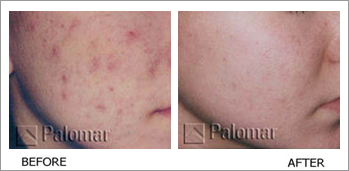 
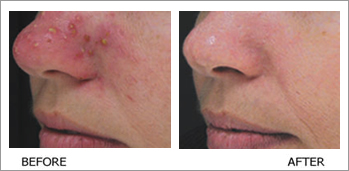 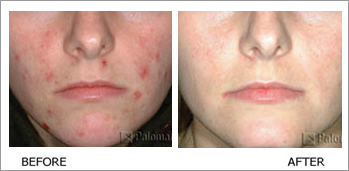
TRAUMATIC and SURGICAL Scars:
Improvement seen with single Tx at 3-4 weeks – continued improvement over time, additional Tx.
How are scars formed?
When the skin is cut or broken, the body mobilizes a wound repair process. The blood vessels constrict and clots form to minimize blood loss. A scab, or hardened crust, forms over the top of the wound. The scab acts like a natural covering to protect the area while the body continues the repair process. Tiny fibres of collagen fill in the hole and eventually reconnect the ends. By the time the scab naturally falls off, much of the initial repair has been finished. However, the area is far from healed. Depending upon the size, depth and location of the injury, it can take months to years for the skin to return to normal strength.
Scar formation is a natural part of the healing process. A scar forms from excess amounts of collagen in the wound as the body attempts a repair. Many scars eventually fade. But they tend not to go away completely. Generally, the larger the wound, the longer it takes to heal and the greater the chance of a visible scar
On average most scars take at least one year to fade. However, researchers have found a way to lessen their severity by injecting the drug, Anti-wrinkle injections near the site of the wound. When a person experiences another kind of injury, like a broken bone, doctors place the area in a sling to immobilize the limb and allow the body to heal. Anti-wrinkle injections works in a similar fashion. When injected into muscles near the wound, the drug prevents the muscles from pulling on the wound site, allowing the area to heal without excessive disruption.
Studies have shown Anti-wrinkle injections is effective in reducing scar formation from facial wounds. Researchers still need to determine if the drug may be effective for other places on the body. The sooner after an injury the patient receives Anti-wrinkle injections, the better the results.
BEFORE AND AFTER PICTURES - Traumatic / Surgical Scars:
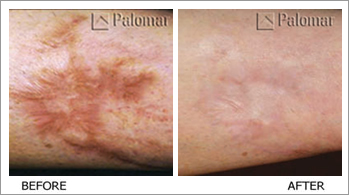 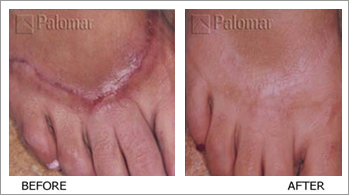
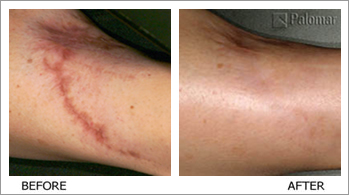 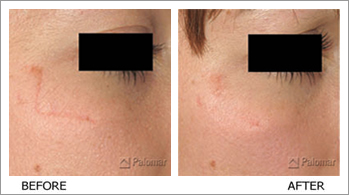
In Office Therapies:
We offer combinations of exfoliation, light and laser therapies such as Palomar Laser treatments, Dermaroller Skin Needling, and Chemical peels, to improve the appearance of scars As each patient's case is different; we will tailor a treatment program specifically for you and your circumstances. A highly professional team led by a medical doctor assesses every patient and an appropriate combination treatment is recommended dependant on expectations, budget, time and medical conditions.
Sinclair Aesthetics Tip:
This procedure uses a revolutionary pulse width to shrink the vessels causing the redness in scars and stops abnormal growth that is implicated in keloids scars. It, offers predictable, repeatable results for scars with minimal discomfort and no downtime.
STRIAE - Stretchmarks:
-
Associated with stretching of the skin.
-
Glucocorticoid hormones prevent fibroblasts from forming collagen & elastin fibrils necessary to keep rapidly growing skin taunt.
-
Creates a lack of supportive material as the skin is stretched leading to epidermal and dermal tears.
-
Histologically stretch marks seem to represent a region of skin with absent or disorganized collagen bundles.
-
Striae may also occur as a result of abnormal collagen formation, or a result of medications or chemicals that interfere with collagen formation.
-
May also be associated with longtime use of cortisone compounds, diabetes, Cushing disease, Ehlers-Danlos syndrome, post-pregnancy, and rapid weight gain or increased muscle girth.
-
75-90% of women develop some degree of stretch marks during pregnancy. The sustained hormone levels usually results in appearance during month 6-7.
BEFORE AND AFTER PICTURES - Stretchmarks:
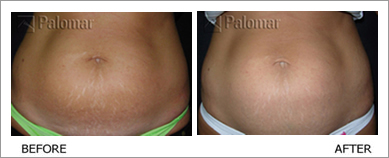 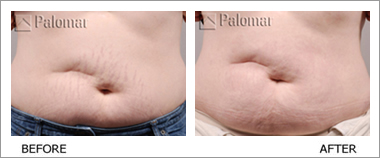
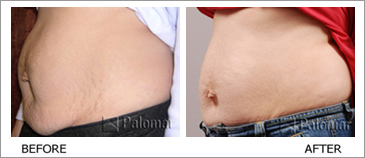 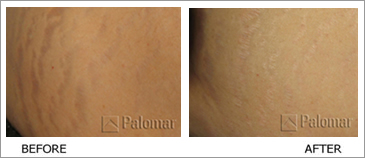
Post-Treatment Guidelines:
-
Application of cool gels packs and topical creams immediately following treatment can help alleviate post treatment itchiness and stinging that may occur.
-
Edema, and sometimes blanching, is expected immediately post treatment and generally resolves within 24-48 hours. It may last up to 3-5 days in some clients.
-
Clients may experience significant redness, broken capillaries or bronzing in the treatment area for 1-3 days after treatment. This may persist in a mild form for several weeks particular in areas other than the face.
-
Gentle cleansing and use of non-irritant cosmetics is permitted after treatment. The use of retinoid should be avoided during the treatment period.
-
New skin will begin to form and it is essential to avoid injury and sun exposure at least two weeks following treatments. It is highly recommended that clients use a sunscreen containing UVA/UVB protection along with a sun blocker.
-
Client should also continue to use SPF up to six months following finale treatment whenever they are outside.
-
Once the treated area has healed, some itching or dryness may occur. This will gradually clear. The use of non0irritant moisturizers may provide some relief.
Possible Side-Effects:
- A low risk of prolonged itching, redness and blistering.
- A risk of hyper-pigmentation, hypo-pigmentation, burns, bruising, erosion or blistering may occur, some of which may result in scarring. These complications are usually due to use of excessive energy levels.
Advise your client being treated to call their treatment provider if side effects occur.
|